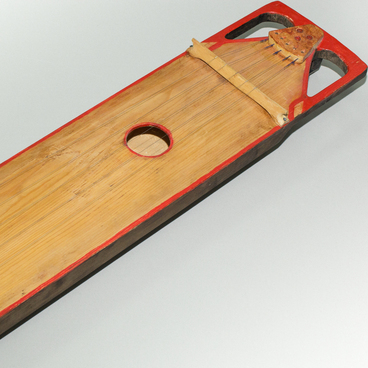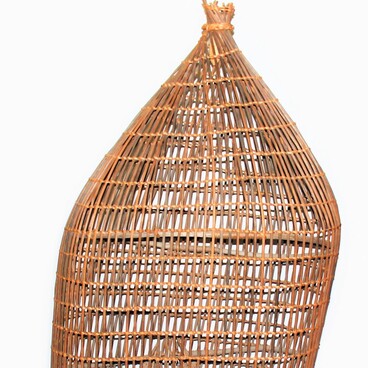On the territory of the Nefteyugansk District, there are two groups of the Khanty — the Salym and the Yugan Khanty. Differences in their cultures can be traced in language, traditional economy, occupations, and clothing.
After the exploration of Siberia, the Salym Khanty’s way of life began to change, including the attitude to the national costume. The Salym Khanty acquired inexpensive Russian clothes, and almost never wore authentic clothes. The Yugan Khanty, on the contrary, continued to sew from skins, moreover, their traditional outfits are still worn.
For a long time it was believed that in the climatic conditions of the North, clothes could not be worn without fasteners. However, the researchers found out that this is not true. The Museum of the Ob River exhibits a rare men’s winter sak of the Yugan Khanty group. “Sak” is a common name for women’s and men’s unbuttoned clothing.
Sak was sewn from fabric and fur. Each northern ethnic group had its variety of these unbuttoned clothes. The sak of the eastern group, to which the Yugan Khanty belongs, is distinguished by the fact that its right edge is wrapped on the left side, and then kilted with a soft long belt. For the rest of the Khanty groups, the edges are fastened with strings, and the belt is practically not used. According to researchers, the Khanty could inherit the sak from the ancient Turks who came to Siberia from the south. The Turks wore long robes with a wrap on the left, a wide strip of fabric of a different color was sewn along the upper edge.
The men’s winter sak from the Ugra Heritage exhibition was sewn from dark blue cloth and otter fur. On the front side of the exhibit, there are five pairs of ties made of light gray rovduga — buckskin suede. The right edge and bottom of the coat are trimmed with fur. Because of the wrap, only the right side of this coat is mainly decorated. The lining of the winter sak is sewn with tendon threads from sheepskin and skins of black-throated loon, as well as from swan and hare skins.
The Ob-Ugrians often used bird skins for sewing. The first mention of clothing with bird plumage is found in ethnographic sources at the beginning of the 18th century. For the longest time, loon skins were in use among the eastern Khanty — until the beginning of the 20th century. Few clothing items made from the skins of birds have been preserved, because it is a fragile material. The indigenous inhabitants of the Far North hunted the black-throated loon not only for the skin, but also for the meat. Nowadays, loon hunting has been suspended, and in some regions, this bird is included in the IUCN Red List.
Furs, as a lining material, have advantages over buckskin: it is more durable and lightweight, you can move freely and silently in it. The lining made of furs and bird skins guaranteed the owner of the clothes warmth and protection from moisture.
After the exploration of Siberia, the Salym Khanty’s way of life began to change, including the attitude to the national costume. The Salym Khanty acquired inexpensive Russian clothes, and almost never wore authentic clothes. The Yugan Khanty, on the contrary, continued to sew from skins, moreover, their traditional outfits are still worn.
For a long time it was believed that in the climatic conditions of the North, clothes could not be worn without fasteners. However, the researchers found out that this is not true. The Museum of the Ob River exhibits a rare men’s winter sak of the Yugan Khanty group. “Sak” is a common name for women’s and men’s unbuttoned clothing.
Sak was sewn from fabric and fur. Each northern ethnic group had its variety of these unbuttoned clothes. The sak of the eastern group, to which the Yugan Khanty belongs, is distinguished by the fact that its right edge is wrapped on the left side, and then kilted with a soft long belt. For the rest of the Khanty groups, the edges are fastened with strings, and the belt is practically not used. According to researchers, the Khanty could inherit the sak from the ancient Turks who came to Siberia from the south. The Turks wore long robes with a wrap on the left, a wide strip of fabric of a different color was sewn along the upper edge.
The men’s winter sak from the Ugra Heritage exhibition was sewn from dark blue cloth and otter fur. On the front side of the exhibit, there are five pairs of ties made of light gray rovduga — buckskin suede. The right edge and bottom of the coat are trimmed with fur. Because of the wrap, only the right side of this coat is mainly decorated. The lining of the winter sak is sewn with tendon threads from sheepskin and skins of black-throated loon, as well as from swan and hare skins.
The Ob-Ugrians often used bird skins for sewing. The first mention of clothing with bird plumage is found in ethnographic sources at the beginning of the 18th century. For the longest time, loon skins were in use among the eastern Khanty — until the beginning of the 20th century. Few clothing items made from the skins of birds have been preserved, because it is a fragile material. The indigenous inhabitants of the Far North hunted the black-throated loon not only for the skin, but also for the meat. Nowadays, loon hunting has been suspended, and in some regions, this bird is included in the IUCN Red List.
Furs, as a lining material, have advantages over buckskin: it is more durable and lightweight, you can move freely and silently in it. The lining made of furs and bird skins guaranteed the owner of the clothes warmth and protection from moisture.



